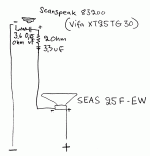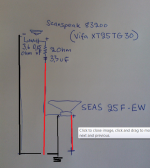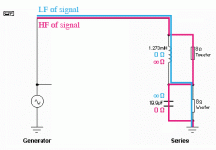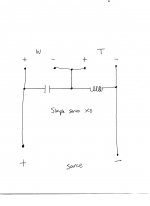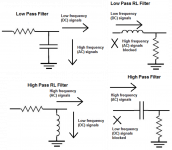So what do I not understand? First, I know that if you dont know what you are doing, dont do it. And beginners should build proven designs etc. And yes, I admit, it all serves me right - however...
I attempted to build a two- way with a (sort of) series crossover. Actually, its not really a crossover, since the woofer, a SEAS 25F - EW ( the same that used to sit in Dynaco A25 - a woofer with nice natural roll-off and proven to work in a two way without an XO ) Anyway the woofer is connected in series witha a Scanspeak 83200 ( identical to Vifa XT25TG30) via a 3.3 uF capacitor and a 2 Ohm resistor. The tweeter also has a Zobel ( 0.15 uF and 3.6 Ohm ) ( the reason for the series connection is a matter of impedance, they are both nominally 4 Ohms and I intend to run this two-way in parallell with a Diatone p-610 8 Ohm full range. If this is a stupid idea or not can be discussed, but that is not the issue here) Anyway, as soon as I connect the tweeter the bass totally disappears. The woofer runs fine by itself, but as soon as the tweeter connects the woofer is barely audible. As I have stated, I am a beginner and my understanding of things is limited. At first I couldnt understand at all. Then I started to think in terms of the circuit. Signal goes from + on speaker terminal to + on woofer, out thru - and thru the cap and resistor to + oo tweeter and back to - on speaker terminal. That meant, I thought, that the bass filters off in the tweeter cap before completion of the circuit in the speaker terminal ground. Then I realized that if that was to be true, series crossovers wouldnt be a possibility at all. I have also seen that the series XO schematics I have found starts on the + of the tweeter. Could that be the problem? Should the circuit start on speaker terminal + to cap and resistor and then + on tweeter, then from - on the tweeter to + on the woofer and finally from - on the woofer to - on the speaker terminal? But then the whole signal would most definately have its bass filtered off by the tweeter cap?
I understand that I made this mess myself and dont deserve any help - but if somebody could tell me what I did wrong, I would most certainely be forever grateful. I include a picture of my wiring...
I attempted to build a two- way with a (sort of) series crossover. Actually, its not really a crossover, since the woofer, a SEAS 25F - EW ( the same that used to sit in Dynaco A25 - a woofer with nice natural roll-off and proven to work in a two way without an XO ) Anyway the woofer is connected in series witha a Scanspeak 83200 ( identical to Vifa XT25TG30) via a 3.3 uF capacitor and a 2 Ohm resistor. The tweeter also has a Zobel ( 0.15 uF and 3.6 Ohm ) ( the reason for the series connection is a matter of impedance, they are both nominally 4 Ohms and I intend to run this two-way in parallell with a Diatone p-610 8 Ohm full range. If this is a stupid idea or not can be discussed, but that is not the issue here) Anyway, as soon as I connect the tweeter the bass totally disappears. The woofer runs fine by itself, but as soon as the tweeter connects the woofer is barely audible. As I have stated, I am a beginner and my understanding of things is limited. At first I couldnt understand at all. Then I started to think in terms of the circuit. Signal goes from + on speaker terminal to + on woofer, out thru - and thru the cap and resistor to + oo tweeter and back to - on speaker terminal. That meant, I thought, that the bass filters off in the tweeter cap before completion of the circuit in the speaker terminal ground. Then I realized that if that was to be true, series crossovers wouldnt be a possibility at all. I have also seen that the series XO schematics I have found starts on the + of the tweeter. Could that be the problem? Should the circuit start on speaker terminal + to cap and resistor and then + on tweeter, then from - on the tweeter to + on the woofer and finally from - on the woofer to - on the speaker terminal? But then the whole signal would most definately have its bass filtered off by the tweeter cap?
I understand that I made this mess myself and dont deserve any help - but if somebody could tell me what I did wrong, I would most certainely be forever grateful. I include a picture of my wiring...
Attachments
Start by wiring this parallel. The impedance doesn't drop except where the two drivers are carrying the same frequencies. This is most important to note down in the lower frequencies which doesn't happen when you have a high pass on the tweeter. When run parallel, the overlap will only happen starting just below the XO frequency and up. That won't hurt your amp as your bass driver has a rising impedance with frequency. Try it with just the cap and resistor first, no zobel.
For doing a series XO, you'll want a cap shunting the woofer and a coil shunting the tweeter, while the two drivers are wired in series.
For doing a series XO, you'll want a cap shunting the woofer and a coil shunting the tweeter, while the two drivers are wired in series.
Nah, put an inductor across the tweeter.
If the tweeter needs a series resistor to make it quieter, put make sure that's between the tweeter and the inductor.
Capacitor goes in parallel with the woofer.
Inductors pass bass, caps pass treble.
So the inductor must provide a path for the bass to get to the woofer, and the cap must provide a path for treble to get to the tweeter.
If the tweeter needs a series resistor to make it quieter, put make sure that's between the tweeter and the inductor.
Capacitor goes in parallel with the woofer.
Inductors pass bass, caps pass treble.
So the inductor must provide a path for the bass to get to the woofer, and the cap must provide a path for treble to get to the tweeter.
Yes, that is the solution closest to mind ( and the easiest for me ). Never the less I would like to learn from my mistakes, so I am keen on understanding why it doesnt work. I am sure that I have misunderstood something. Searching the web, and this forum, I have found the Acoustic Reality serial XO and variations of it. As I have the same tweeter, the ring radiator (scanspeak/vifa) I am kind of intrigued. But that goes from + on terminal to - on tweeter, from + on tweeter to + on woofer and then - on woofer to - on terminal.(?) So there is something that I dont understand about the concept of series crossovers. Also this particular XO (the AR SXO) is capless in the original version and I´m asking myself what the consequences are - that means you are giving the tweeter the full signal. Can you do that? I know the Vifa/Scanspeak ringradiator works all the way down to 500hz or so, but whar about the lower frequencies below that, wont they make the tweeter sound bad? ( naive question, I know , but that is where I´m at...) Anybody with suggestions about how to wire my drivers in series with the lowest parts-count possible? The woofer rolls off by itself and if it is possible to run the tweeter without a cap I might want to give it a try. But I do think I need to understand the basics of how to wire in series as I obviously got something wrong in my first attempt.
OK, for doing a basic series XO you follow the last part of my post.
Remember this: In a series XO the drivers are in series and the components are in parallel with the drivers. In a parallel XO the drivers are in parallel and the components are in series with the drivers. There are other components involved but those are the basics of the two XO's.
The reason yours doesn't work is that you have the drivers in series but you also have the 2Ω resistor and 3.3 µfd cap in series so your bass drivers is not getting any lows, you cut them off with the cap.
Your tweeter has a usable range of 1.5Khz and up according to the manufacturer.
The simplest way to wire it to get started is in my previous post.
Remember this: In a series XO the drivers are in series and the components are in parallel with the drivers. In a parallel XO the drivers are in parallel and the components are in series with the drivers. There are other components involved but those are the basics of the two XO's.
The reason yours doesn't work is that you have the drivers in series but you also have the 2Ω resistor and 3.3 µfd cap in series so your bass drivers is not getting any lows, you cut them off with the cap.
Your tweeter has a usable range of 1.5Khz and up according to the manufacturer.
The simplest way to wire it to get started is in my previous post.
First of all, thanks for the help, both of you. So I was right in thinking that the cap took away the lows. And I dont mind skipping the zobel. But if all I want is protecting the tweeter from damaging lows ( both for the tweeter and the sound itself ) but want the woofer to run in full fredom - so to speak - and also to attenuate the tweeter a bit, where do I put those components in a series connection? And should the circuit run in another way than now? And lastly, in a series two-way, is it imperative (which I am guessing from your posts) to have an inductor in the circuit to pass the lows to the woofer. I suppose that inductor then must have the ability to pass lows below the lowest frequency of the woofer ( or the box design...)
First of all you're welcome.
Probably best to run the drivers in parallel but with the 3.3µfd cap and 2Ω resistor in series with the tweeter, the woofer doesn't reach that high, you have a cap that is too small and will cut off the lows way too high. There will be a big hole in the frequency response.
I have to leave for work now so hopefully someone can help a little more.
Probably best to run the drivers in parallel but with the 3.3µfd cap and 2Ω resistor in series with the tweeter, the woofer doesn't reach that high, you have a cap that is too small and will cut off the lows way too high. There will be a big hole in the frequency response.
I have to leave for work now so hopefully someone can help a little more.
well yes, and adding that wire gives me a parallel connection. and this it what I will do. I´m not sure I understand the post stating that I would still have 4 ohms with the series, I was under the impression - all other factors excluded - that parallell = half the impedance, series = double the impedance? but I do know that frequency-range of the drivers changes matters. anyway, I can see that I totally missed the fact that series xo is a completely different animal. for now I will go for the parallel connection since that is the components that I calculated with and have...and then I will have to go back to the schoolbench and learn some more about designparameters of the series xo.
Yes, but there is a major "other factor": the crossover. In a parallel crossover with 4Ω drivers, you get a 4Ω nominal speaker, not a 2Ω, right? That's because the HF crossover makes the tweeter approximately infinite impedance at low frequencies, and the LF crossover makes the woofer approximately infinite impedance at high frequencies. In a series XO, it's the same kind of situation:I´m not sure I understand the post stating that I would still have 4 ohms with the series, I was under the impression - all other factors excluded - that parallell = half the impedance, series = double the impedance?
Attachments
Didn't pay close enough attention to the first post, my bad.Hold on a minute here, a series crossover here is still going to result in a 4Ω nominal speaker, so this isn't helping you with your goal of an 8Ω+ speaker in the first place.
And disconnect the series part but that still leaves a huge hole in the middle.Doesn't tho OP just need to add a wire?
This was explained in earlier posts.half the impedance, series = double the impedance?
Uh, you might want to do those calculations again. No way what you have is going to work.for now I will go for the parallel connection since that is the components that I calculated with and have...
thanks all of you. I´m getting the high and low pass thing in a series now. as far as capacitorvalue ( in a parallell ) yeah, calculation gives 26.5 uf for 1500hz, but for instance the madisonsound A26 ( which I am somewhat inspired by, it being a modern rendition of the Dynaco A25 which had the woofer I am using ) uses 3.3 uf as its only xo component apart from a attenuating resistor....? and returning to the simple series xo suggested, where would I put a resistor attenuating the tweeter?
I would think you might have abandoned the series XO idea by now. Remember the cart before the horse? I think it would be best if you considered a 2nd order XO on the tweeter and maybe just a 1st order on the woofer. Less than 2nd order will give you low power handling on your tweeter. At 1500hz, your tweeter is pretty close to 4 ohms. If you look at the T/S on them and add your 2Ω resistor to the equation, look up what components you need for that set up.
For the 2nd order on the tweeter you might try 18µfd in series followed by 0.63 mH shunting. This is judging by a 4+2=6Ω impedance at 1.5khz
For first order on the woofer try a 2.5mH coil in series as you woofer looks to have an impedance of around 17 ohms at 1.5kHz.
Unless of course you want to put a zobel on the woofer to flatten it's impedance in which case someone else can help as I have to go home now.
You still might need BSC depending on your box and your tastes.
For first order on the woofer try a 2.5mH coil in series as you woofer looks to have an impedance of around 17 ohms at 1.5kHz.
Unless of course you want to put a zobel on the woofer to flatten it's impedance in which case someone else can help as I have to go home now.
You still might need BSC depending on your box and your tastes.
A primer for SXO's...
Tips! Volume 3, Section B.. Series Xovers.... - Blogs - Techtalk Speaker Building, Audio, Video Discussion Forum
If you want to know about SXO's, this should get you started.
Later,
Wolf
Tips! Volume 3, Section B.. Series Xovers.... - Blogs - Techtalk Speaker Building, Audio, Video Discussion Forum
If you want to know about SXO's, this should get you started.
Later,
Wolf
The AR-SXO series filter
http://www.karma-audio.dk/Delefilter-uden-kondensator.html
It's not a xo that will work on all combinations of speakers. Some will state this, but it's not true. But it's simple, cheap, and can be tuned by ear. And i definatly have potential.
The main difference between parallel and series is that series xo is one circuit and a parallel is 2 circuits for 2-way, three circuits for 3-way etc.
In a parallel filter you can have completely different xo points. That's not possible with the series xo. You also can't bi-amp speaker with series xo
http://www.karma-audio.dk/Delefilter-uden-kondensator.html
It's not a xo that will work on all combinations of speakers. Some will state this, but it's not true. But it's simple, cheap, and can be tuned by ear. And i definatly have potential.
The main difference between parallel and series is that series xo is one circuit and a parallel is 2 circuits for 2-way, three circuits for 3-way etc.
In a parallel filter you can have completely different xo points. That's not possible with the series xo. You also can't bi-amp speaker with series xo
- Status
- This old topic is closed. If you want to reopen this topic, contact a moderator using the "Report Post" button.
- Home
- Loudspeakers
- Multi-Way
- series crossover - what did I do wrong?
